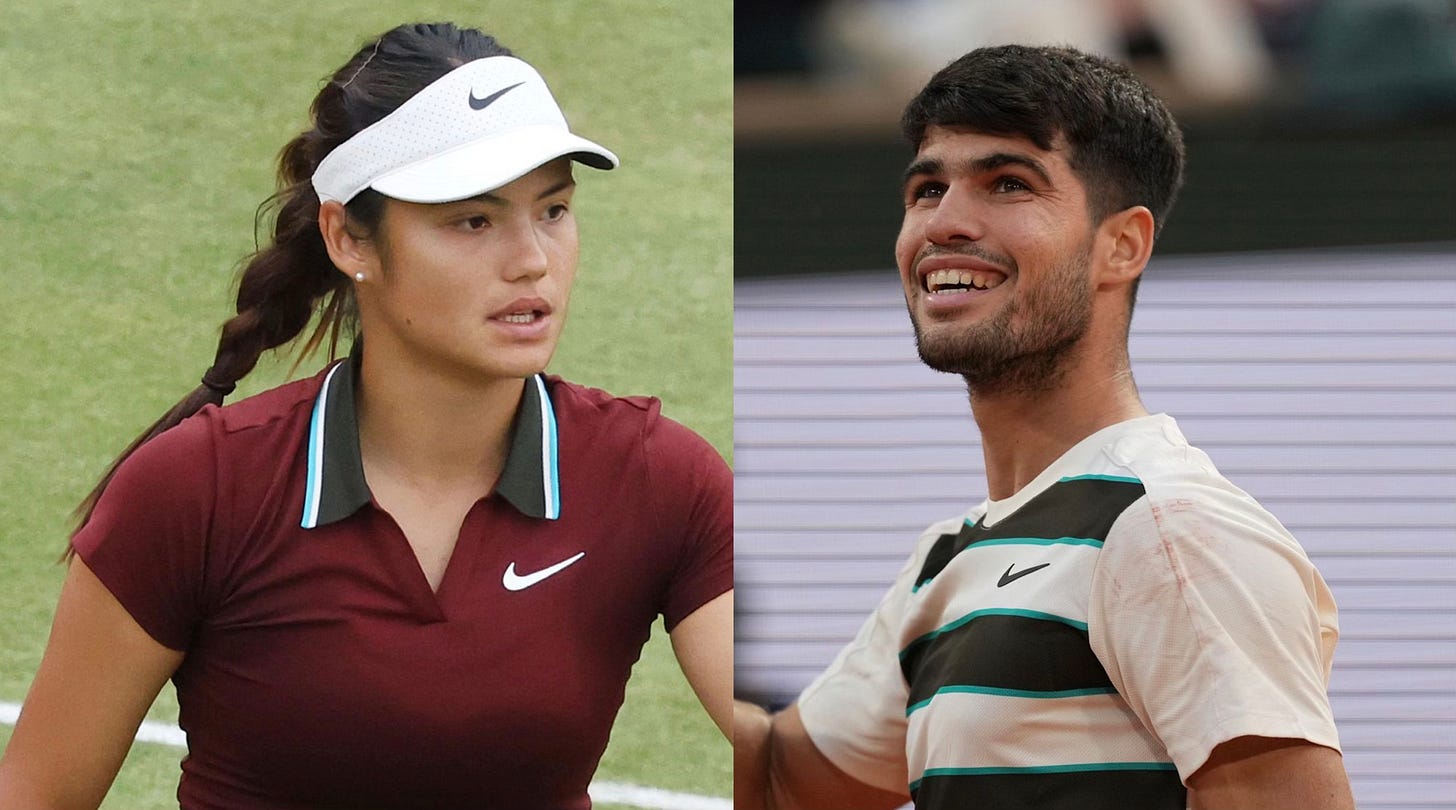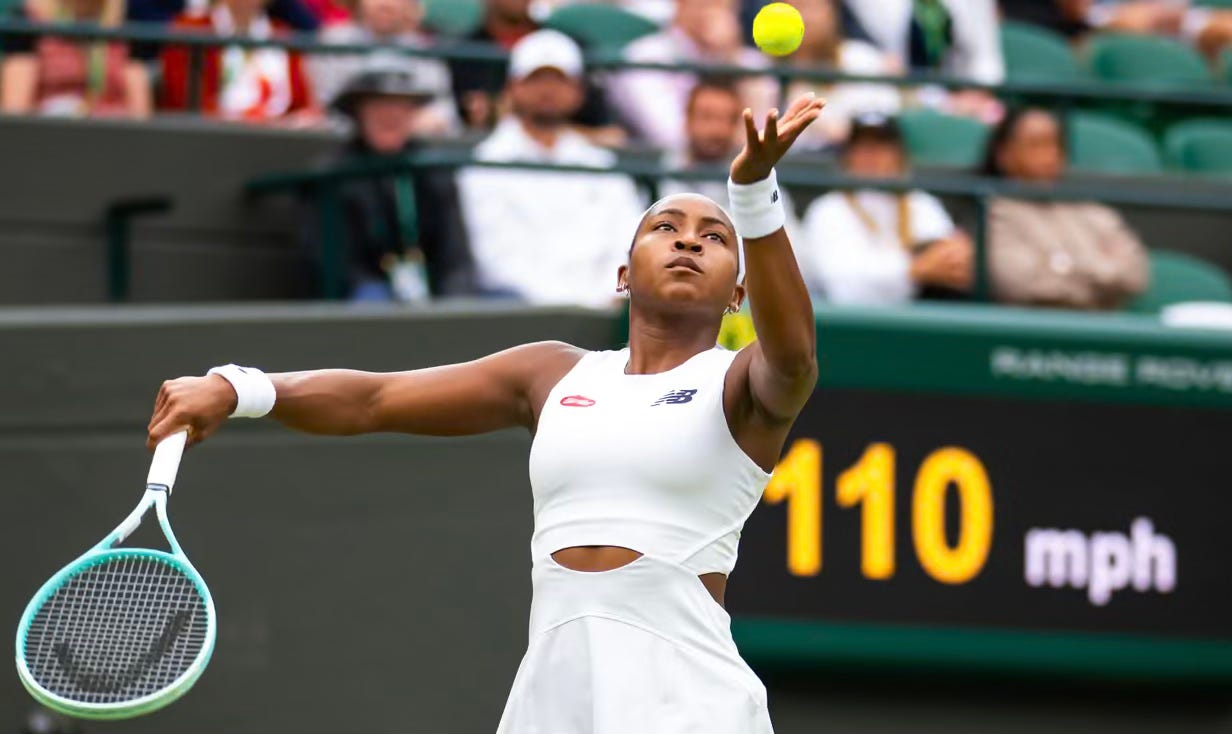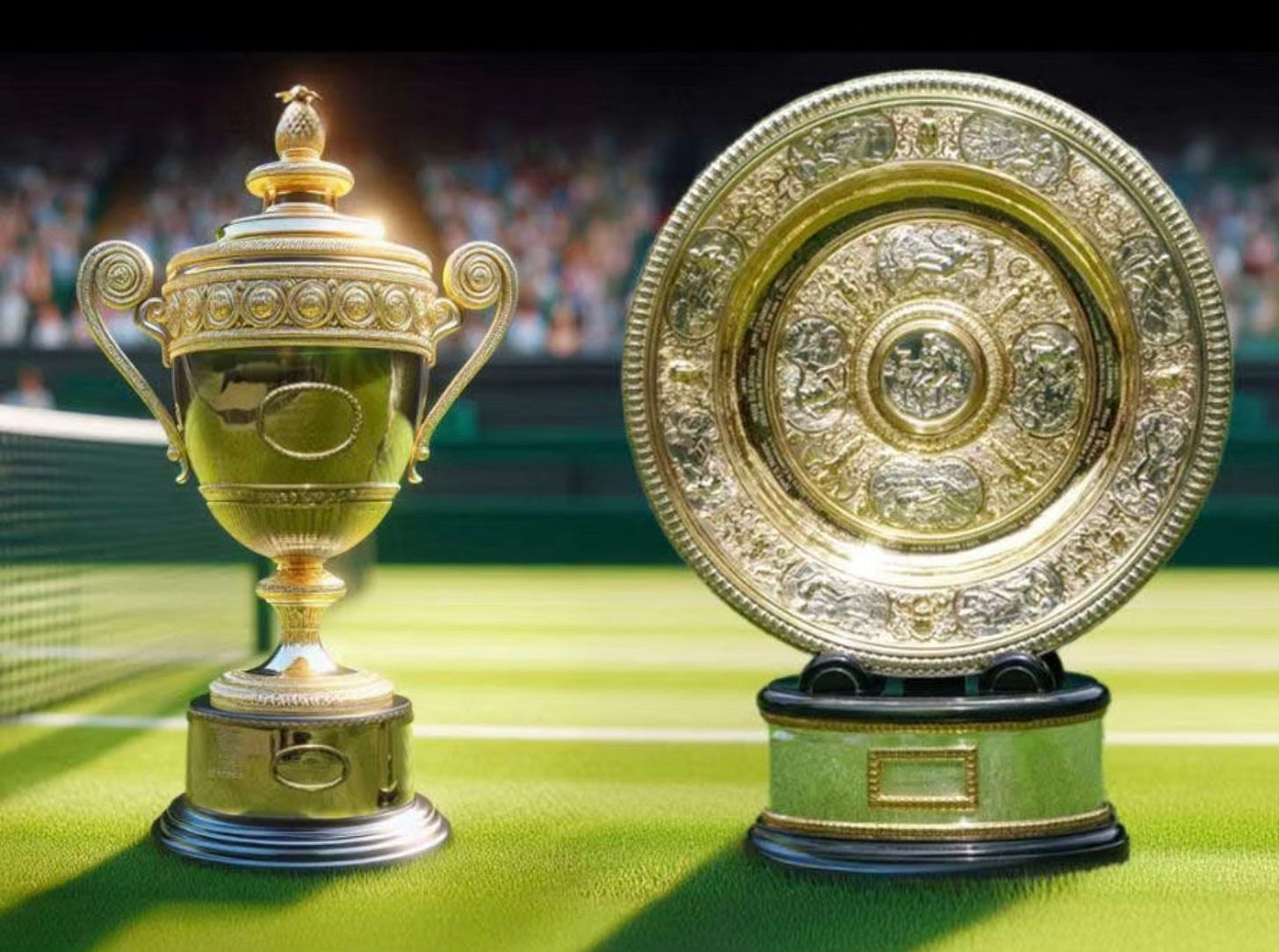You cannot be serious.
If you love Wimbledon, you may find this unorthodox preview of the tournament entertaining and useful. Or not.
The most wonderful thing about the word tennis is that it wasn’t originally a word. The game we know now originated in medieval France as ‘jeu de palme’ – effectively ‘handball’ – and was played successively with hands, gloves, paddles and rackets. When serving, the French liked to shout ‘Tenez!’ meaning ‘Take it!’ or ‘coming at you, heads up’ and the Italians, early adopters of the game, decided to call it tennis.
The sport’s intricate, international roots contrast with the thoroughly British character of Wimbledon, a tournament which is a sporting, social and cultural highlight. Jimmy Connors, men’s singles champion in 1974 and 1982, once summed up what makes the Championship so distinctive: “New Yorkers love it when you spill your guts up at the US Open. At Wimbledon, they make you stop and clean it up.”
If Richard Curtis was ever asked to invent a sporting event that embodied the charming, idealised and quaint England he projects in such films as Four Weddings and a Funeral, he would create Wimbledon. The fabled (and expensive) strawberries and cream, insistence on players wearing white (although women can wear dark undershorts if they are worried about menstruating) and the royal seal of approval (the present king’s grandfather George VI played, and lost, in the men’s doubles in 1926) protect the tournament’s traditional character so effectively that it doesn’t matter much if the British don’t succeed. (For completists, iGreat Britain has won the men’s singles once, women’s singles twice, men’s doubles twice, and mixed doubles five times in the Open era.)
It’s almost as if the British, as spectators not participants, have taken Rudyard Kipling’s line “If you can meet triumph and disaster and treat those two impostors just the same”, engraved on the wall of the players’ entrance at Centre Court, too seriously.
If you love Wimbledon, you may find this unorthodox preview of the tournament entertaining and useful. Or not.
Four things that will be different
1. Three becomes two – but for how long?
As Big Threes go, Novak Djokovic, Roger Federer, and Rafael Nadal, were right up there with Churchill, Roosevelt and Stalin in World War II but the 38-year-old Serbian is the only one still competing. His record at Wimbledon – he has won 97 matches and lost 12, reaching the final 10 times in 19 appearances – has made him third favourite behind Carlos Alcaraz and Jannik Sinner.
The rivalry between Alcaraz and Sinner, the two highest ranked men’s players, vividly illustrated in their epic French Open final, certainly heralds a changing of the guard. The question now is will the men’s game be dominated by a dynamic duo, as in the heyday of Bjorg v McEnroe? Or can such contenders as Jack Draper, Alexander Zverev or Taylor Fritz compete at the very top? All that said, Djokovic knows that this will be one of his last, best chances to equal Federer’s Wimbledon record of eight singles titles.
2. The players won a pay raise.
The £53.5m prize pot at this year’s tournament means that even those who are knocked out in the first round in the singles will earn £65,000 while the winners will take home £3m each. Alcaraz is much more likely to collect that tidy sum than Barbora Krejcikova, last year’s women’s champion, who has struggled with a back injury.
History is slightly against the Czech star: no one has retained the women’s singles title since Serena Williams in 2016. The clear favourites this year are world No1, Belarusian Aryna Sabalenka, a two-time Wimbledon semi-finalist who has reached more Grand Slam finals – six – than anyone since Serena and Venus Williams retired – and her fiercest rival America’s Coco Gauff, who defeated her in the French Open final. History is also slightly against Gauff. Only seven women have won the French Open and Wimbledon in the same season and, inevitably, only Serena Williams has accomplished that this century.
Andy Roddick believes that Gauff’s forehand and serve must improve if she is to prosper on grass – she has never got past the fourth round at Wimbledon – and suggests that fellow American Jessica Pegula, a quarter-finalist last year, is a serious contender. Mind you, as the past ten grand slams have been won by six players, any one of the top eight seeds, especially China’s Qinwen Zheng, America’s Madison Keys and Poland’s Iga Swiatek, could triumph. It is harder to envisage Emma Raducanu and Katie Boulter – neither of whom have reached the quarter-finals at Wimbledon – emulating Virginia Wade, the last Briton to win the women’s singles back in 1977, but they could still do well.
3. The judges got fired.
For those of us who enjoy seeing men and women of a certain age in navy jackets, pinstriped shirts and white trousers or skirts trying not to melt in the heat, the sad news is that there will be no line judges at Wimbledon 2025. The organisers have, a tad reluctantly, sacrificed pageantry for progress, adopting the Electronic Line Calling Live system. Viewers who prefer their tennis served with a side dish of psychodrama needn't worry unduly. Players can still channel their inner McEnroe by shouting “You are the absolute pits of the world!” at the umpire in the chair.
4. The big serve no longer dominates.
No man has played more aces at Wimbledon than America's John Isner who has hit 214. Although that record is likely to be broken by France’s No3 Giovanni Mpetshi Gerricard (who scored 115 in 2024) the days when a big booming serve could propel a player to the semi-finals (as Isner did in 2018) are long gone.
The fastest serve in Wimbledon history was delivered by another American Taylor Dent, who hit an 148 mph ace against Djokovic in the second round in 2010. (He still lost in straight sets.) The women’s record is held by Venus Williams who, in the 2008 women’s final, hit a 129 mph serve when defeating her sister Serena.
The big serve game wasn’t always that popular. The Sun accused Pete Sampras of sending audiences to sleep with his robotic play. Things changed under Djokovic, Federer and Nadal. The latter never hit that many aces while Federer and Djokovic dominated their service games with consistent, precise placement, rather than speed. Sinner is no slouch when serving – he routinely achieves 135mph – but his main aim on grass is to move his opponent out of position to win the rally.
With the balls at Wimbledon playing more slowly than 20 years ago, serving fast and flat is no longer a decisive advantage – especially if you’re not entirely sure where it will land. Many players now rely on topspin and sidespin for their second serve. It gives them more margin for error and the shot is harder to predict – some serves bounce, others don’t – giving opponents less time to react.
Three things that have stayed the same.
1. The playing surface.
Wimbledon is the only Grand Slam tournament played on grass, the fastest and least predictable surface in tennis. This should help British players who are far more likely to have developed their game on this surface and, as the grass court season only lasts five weeks, their international rivals, trained on hard and/or clay courts, have little time to adapt.
To explain why grass is so decisive it is unfortunately necessary to get a bit scientific. One of the crucial factors in tennis is the friction generated when the ball hits the playing surface. Studies show that a sluggish clay court disrupts the ball’s momentum so much that a 67 mph shot, hit without spin, will slow to 38 mph after it bounces. On grass, that same shot will maintain a speed of 45mph.
That doesn’t sound dramatic but Douglas Hoffman, an American materials scientist and college tennis coach, explains: “Let’s say you’re returning a 125 mph serve. Given the length of the court, that means you’ve got about 0.4 seconds to execute your swing. It takes at least 0.25 seconds for your body to execute a movement so that leaves you just over a tenth of a second to decide what to do.” On grass, players can’t weigh their options, they must choose their shot and commit to it.
Then there’s the small matter of the bounce. A ball that hits the grass at an angle of 16° will rebound at the same angle, whereas on clay it will bounce up 20° or more. As Elena Rybakini, the Kazakh player who won Wimbledon in 2022: “You need to stay very low on the legs. The ball is not really coming to you, you need to take the ball earlier." Many of Wimbledon’s greatest players – from Australia’s Ken Rosewall to Steffi Graf, and Federer – have relied on the backhand slice which makes that bounce even lower. This year Alcaraz will look to use that bounce to his advantage with his superb drop shot.
2. The burden of expectation on British players.
The patriotic fervour of the home crowd, reinforced by a slew of ‘will they won’t they?’ stories in the tabloids, creates such a pressure on British players it is reflected in Wimbledon’s (metaphorical) topography as ‘Henman Hill’ became, slightly awkwardly, the ‘Murray Mount’. It is hard to conjure up an appropriate alliterative term for Draper, but that won’t stop the media trying. McEnroe says Draper “can do anything, he’s an excellent volleyer, the serve is huge and he’s in excellent shape. He’s got a lot of big things to look forward to.” A generous endorsement that could prove the kiss of death.
British men’s doubles ace Henry Patten remains under the radar, despite winning the title in 2024, alongside Finnish partner Harri Heliovaara. With nothing to live up to but their own standards, and having won this year’s Australian Open, they have a decent chance of defending their title, as does Norwich City fan Alfie Hewitt who has already won ten grand slams in wheelchair tennis.
At least 56 British players will compete in this year’s tournament. Five men – Draper, Cameron Norrie, Jacob Fearnley, Billy Harris – and three women – Raducanu, Boulter and Sonay Kartal – qualified directly. Six British men – notably former Great Britain No1 Dan Evans – have been given wild cards, as have seven British women including Mika Stojsavljevic (who won the US Open’s girls singles last September) and Heather Watson.
3. The way to win
A 2021 study published by Sheffield Hallam University, which analysed 490 singles matches at Wimbledon, found that players usually prevailed if they won more points on their first serve and from the baseline, saved more breakpoints, hit more aces and committed fewer unforced errors (including double faults). Other factors – such as successful first serves, speed of serve and points won on second serve – had little influence on the outcome. The most profound difference between victory and defeat was which player won the most short rallies (defined as four shots or less) which account for 72% of points in men’s singles and 65% in women’s singles. Long rallies may be thrilling to watch – like the 25-shot contest between Juan Martin Del Potro and Djokovic in the 2013 semi-final – but they don’t often change the game.
A final word of wisdom
If you’ve ever wondered how tennis developed its magnificently lunatic scoring system – which goes from love (derived from oeuf, French for ‘egg’, an appropriately zero-shaped object), to 15, 30, 40, deuce and beyond – heed the wise words of Andre Agassi, men’s singles champion in 1992: “It was invented to cause frustration to those who play.”







